12.8: Mining and Mineral Use
- Page ID
- 2617
\( \newcommand{\vecs}[1]{\overset { \scriptstyle \rightharpoonup} {\mathbf{#1}} } \)
\( \newcommand{\vecd}[1]{\overset{-\!-\!\rightharpoonup}{\vphantom{a}\smash {#1}}} \)
\( \newcommand{\dsum}{\displaystyle\sum\limits} \)
\( \newcommand{\dint}{\displaystyle\int\limits} \)
\( \newcommand{\dlim}{\displaystyle\lim\limits} \)
\( \newcommand{\id}{\mathrm{id}}\) \( \newcommand{\Span}{\mathrm{span}}\)
( \newcommand{\kernel}{\mathrm{null}\,}\) \( \newcommand{\range}{\mathrm{range}\,}\)
\( \newcommand{\RealPart}{\mathrm{Re}}\) \( \newcommand{\ImaginaryPart}{\mathrm{Im}}\)
\( \newcommand{\Argument}{\mathrm{Arg}}\) \( \newcommand{\norm}[1]{\| #1 \|}\)
\( \newcommand{\inner}[2]{\langle #1, #2 \rangle}\)
\( \newcommand{\Span}{\mathrm{span}}\)
\( \newcommand{\id}{\mathrm{id}}\)
\( \newcommand{\Span}{\mathrm{span}}\)
\( \newcommand{\kernel}{\mathrm{null}\,}\)
\( \newcommand{\range}{\mathrm{range}\,}\)
\( \newcommand{\RealPart}{\mathrm{Re}}\)
\( \newcommand{\ImaginaryPart}{\mathrm{Im}}\)
\( \newcommand{\Argument}{\mathrm{Arg}}\)
\( \newcommand{\norm}[1]{\| #1 \|}\)
\( \newcommand{\inner}[2]{\langle #1, #2 \rangle}\)
\( \newcommand{\Span}{\mathrm{span}}\) \( \newcommand{\AA}{\unicode[.8,0]{x212B}}\)
\( \newcommand{\vectorA}[1]{\vec{#1}} % arrow\)
\( \newcommand{\vectorAt}[1]{\vec{\text{#1}}} % arrow\)
\( \newcommand{\vectorB}[1]{\overset { \scriptstyle \rightharpoonup} {\mathbf{#1}} } \)
\( \newcommand{\vectorC}[1]{\textbf{#1}} \)
\( \newcommand{\vectorD}[1]{\overrightarrow{#1}} \)
\( \newcommand{\vectorDt}[1]{\overrightarrow{\text{#1}}} \)
\( \newcommand{\vectE}[1]{\overset{-\!-\!\rightharpoonup}{\vphantom{a}\smash{\mathbf {#1}}}} \)
\( \newcommand{\vecs}[1]{\overset { \scriptstyle \rightharpoonup} {\mathbf{#1}} } \)
\( \newcommand{\vecd}[1]{\overset{-\!-\!\rightharpoonup}{\vphantom{a}\smash {#1}}} \)
\(\newcommand{\avec}{\mathbf a}\) \(\newcommand{\bvec}{\mathbf b}\) \(\newcommand{\cvec}{\mathbf c}\) \(\newcommand{\dvec}{\mathbf d}\) \(\newcommand{\dtil}{\widetilde{\mathbf d}}\) \(\newcommand{\evec}{\mathbf e}\) \(\newcommand{\fvec}{\mathbf f}\) \(\newcommand{\nvec}{\mathbf n}\) \(\newcommand{\pvec}{\mathbf p}\) \(\newcommand{\qvec}{\mathbf q}\) \(\newcommand{\svec}{\mathbf s}\) \(\newcommand{\tvec}{\mathbf t}\) \(\newcommand{\uvec}{\mathbf u}\) \(\newcommand{\vvec}{\mathbf v}\) \(\newcommand{\wvec}{\mathbf w}\) \(\newcommand{\xvec}{\mathbf x}\) \(\newcommand{\yvec}{\mathbf y}\) \(\newcommand{\zvec}{\mathbf z}\) \(\newcommand{\rvec}{\mathbf r}\) \(\newcommand{\mvec}{\mathbf m}\) \(\newcommand{\zerovec}{\mathbf 0}\) \(\newcommand{\onevec}{\mathbf 1}\) \(\newcommand{\real}{\mathbb R}\) \(\newcommand{\twovec}[2]{\left[\begin{array}{r}#1 \\ #2 \end{array}\right]}\) \(\newcommand{\ctwovec}[2]{\left[\begin{array}{c}#1 \\ #2 \end{array}\right]}\) \(\newcommand{\threevec}[3]{\left[\begin{array}{r}#1 \\ #2 \\ #3 \end{array}\right]}\) \(\newcommand{\cthreevec}[3]{\left[\begin{array}{c}#1 \\ #2 \\ #3 \end{array}\right]}\) \(\newcommand{\fourvec}[4]{\left[\begin{array}{r}#1 \\ #2 \\ #3 \\ #4 \end{array}\right]}\) \(\newcommand{\cfourvec}[4]{\left[\begin{array}{c}#1 \\ #2 \\ #3 \\ #4 \end{array}\right]}\) \(\newcommand{\fivevec}[5]{\left[\begin{array}{r}#1 \\ #2 \\ #3 \\ #4 \\ #5 \\ \end{array}\right]}\) \(\newcommand{\cfivevec}[5]{\left[\begin{array}{c}#1 \\ #2 \\ #3 \\ #4 \\ #5 \\ \end{array}\right]}\) \(\newcommand{\mattwo}[4]{\left[\begin{array}{rr}#1 \amp #2 \\ #3 \amp #4 \\ \end{array}\right]}\) \(\newcommand{\laspan}[1]{\text{Span}\{#1\}}\) \(\newcommand{\bcal}{\cal B}\) \(\newcommand{\ccal}{\cal C}\) \(\newcommand{\scal}{\cal S}\) \(\newcommand{\wcal}{\cal W}\) \(\newcommand{\ecal}{\cal E}\) \(\newcommand{\coords}[2]{\left\{#1\right\}_{#2}}\) \(\newcommand{\gray}[1]{\color{gray}{#1}}\) \(\newcommand{\lgray}[1]{\color{lightgray}{#1}}\) \(\newcommand{\rank}{\operatorname{rank}}\) \(\newcommand{\row}{\text{Row}}\) \(\newcommand{\col}{\text{Col}}\) \(\renewcommand{\row}{\text{Row}}\) \(\newcommand{\nul}{\text{Nul}}\) \(\newcommand{\var}{\text{Var}}\) \(\newcommand{\corr}{\text{corr}}\) \(\newcommand{\len}[1]{\left|#1\right|}\) \(\newcommand{\bbar}{\overline{\bvec}}\) \(\newcommand{\bhat}{\widehat{\bvec}}\) \(\newcommand{\bperp}{\bvec^\perp}\) \(\newcommand{\xhat}{\widehat{\xvec}}\) \(\newcommand{\vhat}{\widehat{\vvec}}\) \(\newcommand{\uhat}{\widehat{\uvec}}\) \(\newcommand{\what}{\widehat{\wvec}}\) \(\newcommand{\Sighat}{\widehat{\Sigma}}\) \(\newcommand{\lt}{<}\) \(\newcommand{\gt}{>}\) \(\newcommand{\amp}{&}\) \(\definecolor{fillinmathshade}{gray}{0.9}\)INTRODUCTION
Some minerals are very useful. An ore is a rock that contains minerals with useful elements. Aluminum in bauxite ore (figure 1) is extracted from the ground and refined to be used in aluminum foil and many other products. The cost of creating a product from a mineral depends on how abundant the mineral is and how much the extraction and refining processes cost. Environmental damage from these processes is often not figured into a product’s cost. It is important to use mineral resources wisely.
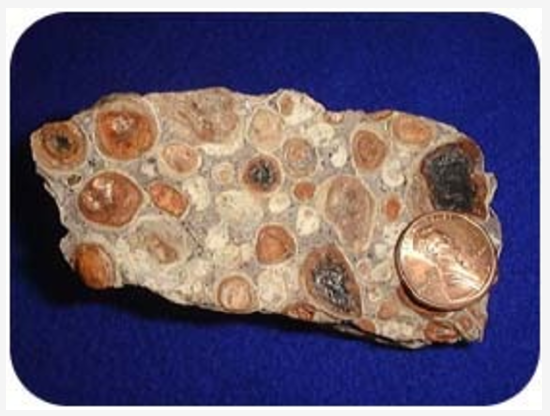
FINDING AND MINING MINERALS
Geologic processes create and concentrate minerals that are valuable natural resources. Geologists study geological formations and then test the physical and chemical properties of soil and rocks to locate possible ores and determine their size and concentration.
A mineral deposit will only be mined if it is profitable. A concentration of minerals is only called an ore deposit if it is profitable to mine. There are many ways to mine ores.
Surface Mining
Surface mining allows extraction of ores that are close to Earth’s surface. Overlying rock is blasted and the rock that contains the valuable minerals is placed in a truck and taken to a refinery. As pictured in figure 2, surface mining includes open-pit mining and mountaintop removal. Other methods of surface mining include strip mining, placer mining, and dredging. Strip mining is like open pit mining but with material removed along a strip.
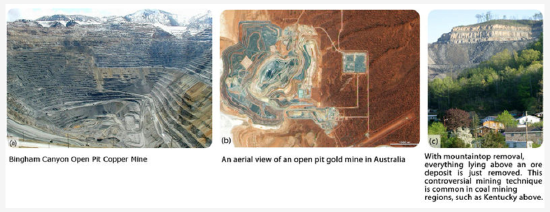
Placers are valuable minerals found in stream gravels. California’s nickname, the Golden State, can be traced back to the discovery of placer deposits of gold in 1848. The gold weathered out of hard metamorphic rock in the western Sierra Nevada, which also contains deposits of copper, lead, zinc, silver, chromite, and other valuable minerals. The gold traveled down rivers and then settled in gravel deposits. Currently, California has active mines for gold and silver and for non-metal minerals such as sand and gravel, which are used for construction.
Underground Mining
Underground mining is used to recover ores that are deeper into Earth’s surface. Miners blast and tunnel into rock to gain access to the ores. How underground mining is approached – from above, below, or sideways – depends on the placement of the ore body, its depth, concentration of ore, and the strength of the surrounding rock.
Underground mining is very expensive and dangerous. Fresh air and lights must also be brought into the tunnels for the miners, and accidents are far too common.
ORE EXTRACTION
The ore’s journey to becoming a useable material is only just beginning when the ore leaves the mine (figure 3). Rocks are crushed so that the valuable minerals can be separated from the waste rock. Then the minerals are separated out of the ore. A few methods for extracting ore are:
- heap leaching: the addition of chemicals, such as cyanide or acid, to remove ore.
- flotation: the addition of a compound that attaches to the valuable mineral and floats.
- smelting: roasting rock, causing it to segregate into layers so the mineral can be extracted.
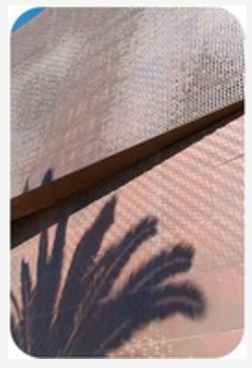
To extract the metal from the ore, the rock is melted at a temperature greater than 900°C, which requires a lot of energy. Extracting metal from rock is so energy intensive that if you recycle just 40 aluminum cans, you will save the energy equivalent of one gallon of gasoline.
MINING AND THE ENVIRONMENT
Although mining provides people with many needed resources, the environmental costs can be high. Surface mining clears the landscape of trees and soil, and nearby streams and lakes are inundated with sediment. Pollutants from the mined rock, such as heavy metals, enter the sediment and water system. Acids flow from some mine sites, changing the composition of nearby waterways (figure 4).
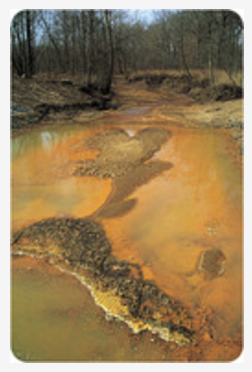
U.S. law has changed so that in recent decades a mine region must be restored to its natural state, a process called reclamation. This is not true of older mines. Pits may be refilled or reshaped and vegetation planted. Pits may be allowed to fill with water and become lakes or may be turned into landfills. Underground mines may be sealed off or left open as homes for bats.
VALUABLE MINERALS
Some minerals are valuable because they are beautiful. Jade has been used for thousands of years in China. Diamonds sparkle on many engagement rings. Minerals like jade, turquoise, diamonds, and emeralds are gemstones. A gemstone, or gem, is a material that is cut and polished for jewelry. Many gemstones, including many in figure 5, are minerals.
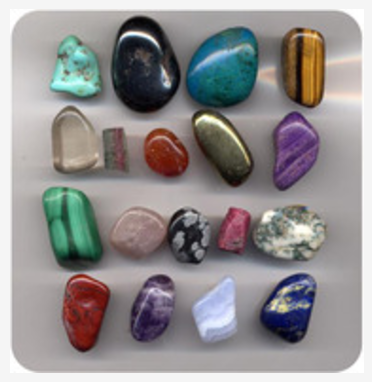
Gemstones are usually rare and do not break or scratch easily. Most are cut along cleavage faces and then polished so that light bounces back off the cleavage planes (figure 6). Light does not pass through gemstones that are opaque, such as turquoise.

Gemstones are not just used in jewelry. Diamonds are used to cut and polish other materials, such as glass and metals, because they are so hard. The mineral corundum, of which ruby and sapphire are varieties, is used in products such as sandpaper.
Minerals are used in much less obvious places. The mineral gypsum is used for the sheetrock in homes. Window glass is made from sand, which is mostly quartz. Halite is mined for rock salt. Copper is used in electrical wiring, and bauxite is the source for the aluminum used in soda cans.
LESSON SUMMARY
- Geologists use many methods to find mineral deposits that will be profitable to mine.
- Ore deposits can be mined by surface or underground mining methods.
- Mining provides important resources but has environmental costs.
- By U.S. law, currently mined land must undergo reclamation. This is not true for old mines.
- Metal ores must be melted to make metals.
- Many gems are cut and polished to increase their beauty.
- Minerals are used in a variety of ways.
REFLECTION QUESTIONS
- What skill does this content help you develop?
- What are the key topics covered in this content?
- How can the content in this section help you demonstrate mastery of a specific skill?
- What questions do you have about this content?
Contributors and Attributions
Original content from Kimberly Schulte (Columbia Basin College) and supplemented by Lumen Learning. The content on this page is copyrighted under a Creative Commons Attribution 4.0 International license.


